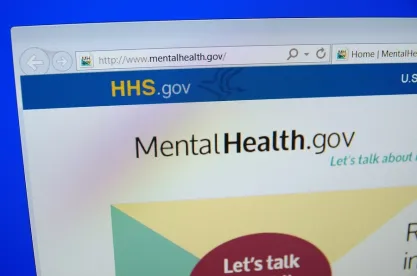On April 23, 2018, the Departments of Labor (DOL), Health and Human Services (HHS) and Treasury (together, the “Agencies”) released proposed frequently asked questions (“FAQs”) related to nonquantitative treatment limitations (“NQTLs”) under the Mental Health Parity and Addiction Equity Act (“MHPAEA”). The Agencies also provided guidance on new disclosure requirements (which were described in our May 15, 2018 blog entry) and released a self-compliance tool.
Perhaps one of the more difficult aspects of mental health parity compliance is applying the parity rules to NQTLs. There is a dearth of concrete guidance on what constitutes a NQTL and how the parity rules apply to NQTLs. The Agencies’ most recent proposed guidance, FAQs about Mental Health and Substance Abuse Disorder Parity Implementation and the 21st Century Cures Act, Part 39 (“FAQs Part 39”), expands on prior NQTL-related guidance by explaining how the parity rules would apply in various hypothetical situations involving NQTLs.
By way of background, the MHPAEA requires that group health plans provide mental health and substance abuse benefits in parity with medical and surgical benefits. Although the requirements are complex, the basic structure of the law is that both quantitative limitations (e.g., dollar and visit limits) and NQTLs (e.g., medical management techniques) applied to mental health and substance abuse benefits must be in parity with the predominant limitations applied to substantially all medical and surgical benefits. This “predominant/substantially all” requirement applies on a classification-by-classification basis, based on six classifications of benefits: (i) inpatient, in-network; (ii) inpatient, out-of-network; (iii) outpatient, in-network; (iv) outpatient, out-of-network; (v) emergency care; and (vi) prescription drugs.
As explained in FAQs Part 39, a plan cannot impose a NQTL with respect to mental health or substance abuse benefits “unless, under the terms of the plan…as written and in operation, any processes, strategies, evidentiary standards, or other factors used in applying the NQTL to [mental health and substance abuse] in the classification are comparable to, and are applied no more stringently than the processes, strategies, evidentiary standards, or other factors used in applying the limitation to medical/surgical benefits in the same classification.” A summary of the key aspects of the Agencies’ guidance on NQTLs is provided below.
-
Blanket Coverage Exclusions. The MHPAEA does not require that a group health plan provide coverage for any particular mental health or substance abuse condition. However, once a plan covers a mental health or substance abuse condition, any quantitative limitations or NQTLs applied to the condition must be in parity with medical/surgical benefits. For example, a group health plan could exclude all services and treatments related to bipolar disorder without violating the MHPAEA. However, if some services or treatments for bipolar disorder are covered, then any limitation applied to that coverage must meet the MHPAEA requirement that coverage for bipolar disorders be in parity with medical/surgical benefits within the relevant classification.
Even though the MHPAEA is not a coverage mandate, plan sponsors of fully-insured plans should be aware that state law coverage mandates might require coverage of particular mental health and substance abuse disorders.
-
Experimental/Investigational Exclusions. An exclusion based on the experimental or investigational nature of a service or treatment is a NQTL. Therefore, the method by which a service or treatment is determined to be experimental or investigational cannot be applied more stringently to mental health and substance abuse benefits than it is to medical/surgical benefits. For example, suppose a plan provides that any treatment (whether mental health/substance abuse or medical/surgical) will be denied as experimental when no professionally recognized treatment guidelines define clinically appropriate standards of care and fewer than two randomized controlled trials support the treatment’s use for a particular condition. Despite the plan language, the plan is administered such that it covers treatment for a medical/surgical condition with only one supporting randomized trial, but it still requires two supporting randomized trials before covering treatment for a mental health/substance abuse condition in the same MHPAEA classification. Because the plan’s experimental/investigational exclusion is applied more stringently to mental health/substance abuse benefits, a MHPAEA violation would have occurred.
That experimental/investigational exclusions are NQTLs is not particularly surprising, as these types of exclusions are one way in which plans can manage medical costs. Nevertheless, the description of this NQTL in the FAQs is noteworthy because the example used involves “applied behavioral analysis” (“ABA”) for treatment of autism spectrum disorder. Many insurers and plans have excluded ABA on the basis that the treatment is experimental or investigational and this has spawned numerous lawsuits alleging violations of state and federal mental health parity laws. Plans that do cover ABA but apply age or other treatment limitations on ABA might also face litigation if the limits are not in parity with limits applied to medical/surgical benefits.
Plans that cover treatment for autism spectrum disorder but deny coverage for ABA therapy under an experimental/investigational exclusion should be mindful of ABA’s growing acceptance as a standard treatment. Continued application of this type of exclusion to ABA may become more difficult to justify over time.
-
Other NQTLs. The Agencies also identified and provided examples for the following NQTLs: prescription drug dosage limitations, step therapy programs, healthcare facility restrictions, and provider network administration (such as network access standard and network adequacy measurements). The message is clear – if any of these limitations are applied to mental health and substance abuse benefits, the method by which a plan determines whether to apply the NQTL and the method to determine the scope of the NQTL cannot be applied more stringently to mental health and substance abuse benefits than it is applied to medical and surgical benefits.
Monitoring compliance with the MHPAEA’s requirements for NQTLs is extremely complicated. In our next blog on mental health parity, we will provide practical steps that plan sponsors and administrators can take to review and monitor compliance. This includes using the new self-compliance tool provided by the Agencies.




 />i
/>i
